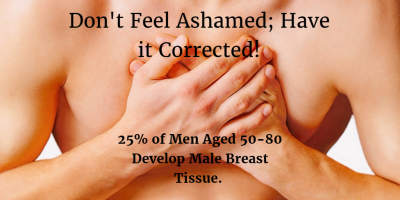Enlarged male breasts, a condition called gynecomastia, are much more common than many people realize. In fact, approximately 40-60% of the male population may experience this condition. Gynecomastia can often result in feelings of self-consciousness, particularly in situations which involve removal of the shirt. Fortunately, this problem can often be significantly improved with an out-patient procedure.
Dr. Jay Orringer can perform a male breast reduction procedure to address gynecomastia. You can learn more about your options by speaking with Dr. Orringer in person. Please contact our Beverly Hills office to schedule a consultation.

What Is Gynecomastia?
Gynecomastia is a condition associated with excess male breast tissue. It often develops during puberty and in many instances, goes away on its own by your early 20s. However, the condition will persist for some men throughout their lives.
There are several potential causes of gynecomastia:
- Hormonal changes
- Weight gain
- Heredity
- Medications and drugs, including steroids and heavy use of marijuana
- Dietary supplements
- Health conditions such as kidney or liver failure, tumors, and hypogonadism
- In many instances the cause is never apparent
Am I a Candidate for Gynecomastia Surgery?
Before deciding whether gynecomastia surgery is right for you, it is important to make sure your condition is not related to the use of certain medications or another health issue. In some instances, treatment of a health problem or discontinuing the use of a supplement or medication may potentially correct the condition without the need for surgery.
In addition, if you are overweight, you may want to improve your diet and exercise regimen before considering surgery. Often, the condition may be significantly improved by achieving and maintaining a healthier body weight.
If these factors are not causing your gynecomastia, then you may be a good candidate for a male breast reduction procedure. In addition, ideal candidates:
- Are in good overall health
- Are not significantly overweight
- Have realistic expectations regarding the outcome of the procedure
- Have good skin elasticity
Your Male Breast Reduction Procedure
During your male breast reduction procedure , Dr. Orringer will remove excess fat and often glandular tissue in order to potentially achieve a more masculine appearance of the chest. Depending upon your specific situation, your gynecomastia surgery may include one or more of the following techniques:
- Liposuction
- Surgical excision of glandular tissue
- Removal of excess skin
Why Choose Dr. Orringer?
Dr. Orringer is a double board certified plastic surgeon with more than 25 years of experience performing male breast reduction procedures. He is very sensitive to the self-consciousness that you may experience from this condition, and he will provide you with compassionate care that respects your privacy and individual concerns during the process.
Gynecomastia FAQs
What causes gynecomastia to persist even in men who are physically fit?

While excess weight may contribute to excess undesired volume of the breasts, true gynecomastia often involves glandular tissue that does not respond to diet or exercise. Particularly in younger patients, a consultation with an endocrinologist may be obtained to rule out hormonal or genetic causes. Marijuana usage and certain medications including some steroids, heart medications, and antidepressants, can cause male breast enlargement, and these possible factors must be considered. In some individuals, even with consistent fitness efforts and ideal body weight, the appearance of the chest may remain unchanged due to the nature of the underlying tissue. For these patients, surgery might offer an option to reduce this fullness and create a more aesthetic breast and chest contour.
How long should I wait before considering gynecomastia surgery?
Dr. Orringer advises that a patient wait until his weight and chest contour has remained stable for an extended period of time. For teenage patients, it is common to wait until most of the physical development has occurred and hormone levels have largely stabilized. Adults may choose to wait until other potential causes, such as medication use or underlying health conditions, have been ruled out or addressed. During consultation with Dr. Orringer, he will determine whether further pre-operative evaluation appears indicated and whether the timing of surgery is appropriate.
Is liposuction alone enough to treat all cases of gynecomastia?
Liposuction may be effective for patients whose fullness is primarily due to excess fatty tissue. However, when dense glandular tissue is present, surgical excision may be necessary to achieve a more complete and pleasing result. Some patients may benefit from a combination of both techniques. In combination with direct removal of the glandular tissue, liposuction can optimize both breast and adjacent chest contour. Dr. Orringer evaluates each patient’s breast and chest characteristics during consultation to determine the most appropriate surgical plan.
Will my skin adjust to the new chest shape after surgery?
Skin elasticity plays an important role in surgical planning. In many younger patients, or those with good skin tone, the skin may retract naturally to accommodate the reduced volume. In cases where skin laxity is present, either due to age, weight loss, or other factors, a skin excision may be recommended to refine the result and optimize shape and contour.
Do I need to stop exercising before or after surgery?
Before surgery, patients are typically encouraged to maintain their usual fitness routine. After surgery, physical activity is limited during the initial recovery phase to protect healing tissues and reduce the risk of complications. Light activity, such as walking, is usually suggested beginning the night after surgery. More strenuous activities, particularly those involving the chest muscles, may require several weeks of rest. Dr. Orringer provides specific guidance based on the extent of the procedure and the patient’s progress.
Is it common to feel self-conscious about this condition?
While every individual experiences gynecomastia differently, it is not uncommon for men with this condition to feel self-conscious and to avoid certain social or athletic situations. Choosing to explore treatment is a personal decision and often stems from a desire to improve physical appearance and emotional comfort. Dr. Orringer strives to achieve an aesthetic, natural chest contour and appearance through a caring and individualized approach to each patient.
Please cal 310-273-1663 to contact Dr. Jay Orringer at The Renaissance Medical Center for Aesthetic Surgery, Inc. to schedule your gynecomastia consultation today. We serve patients in Beverly Hills, Los Angeles, Santa Monica, and Hollywood, California, nationally, and internationally.







